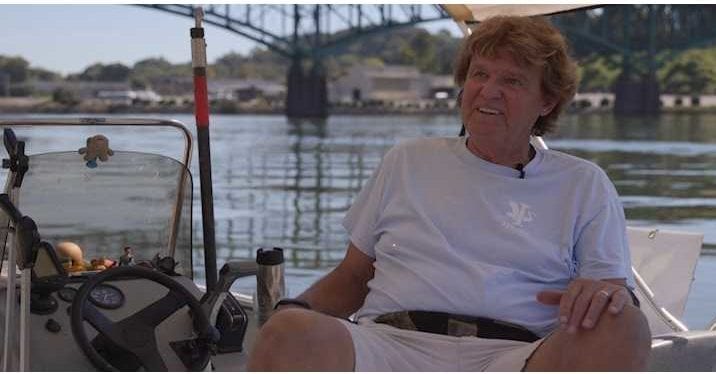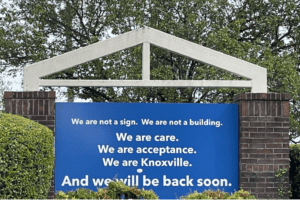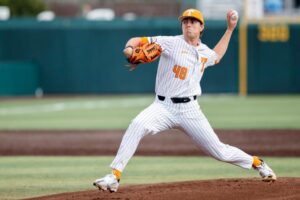There Is No Away
Unclogging the Tennessee River, One Piece of Trash at a Time.

Written by Lisa Oliver
Jake Hudson throws his favorite river souvenir into the Tennessee. The bowling ball falls to the surface of the water where it bounces and begins to spin. The river water covers it in a sheen that causes it to glisten in the mid-day sun.
Hudson starts to fish it back out of the Tennessee River, causing it to spin faster. “Most people don’t know that bowling balls float,” he says. “I didn’t until I fished this one out.” As he retrieves his river memento, his long-handled fish net bends with the weight of the ball in its mesh.
Jake Hudson is the River Captain for Ijams Nature Center. He patrols the Knoxville section of the Tennessee River, pulling trash out five days a week. He has a lifelong love of the river, having spent his youth out on small boats with his father. When he worked for Knoxville’s city engineering department, his office was downtown with a window overlooking the river. “I’d see these logs and trash coming down the river,” he says. “I talked to everybody I could about the city getting a boat, so I could get out and clean the river.”
Most people do not go from an engineering career to trash collector, but Jake Hudson is not like most people. “It’s something I wanted to do for 15 years as I was looking out the window,” he says. “I finally got a chance to do it, so I jumped on it. I was able to retire from the city and go to work picking up trash.” He smiles as he says this.
Now Hudson’s office is a 24-foot boat—and the river he patrols. The boat travels up to the Forks of the River area where the French Broad and Holston rivers meet. The current of both tributaries is strong and steady. The boat glides back downstream. As he pilots the boat, Hudson scans side to side looking for objects in the river. The river does not have much trash in it at the moment. That is thanks to Jake Hudson, but also to a local dry spell. It has been several weeks since it rained in Knoxville. Rainstorms sweep trash into rivers. The plastics make it to the river in a multi-step process. It all starts with an item being dropped, accidentally or not, onto the ground in town.
Say you have a drinking straw, an item that was created to be discarded. The straw starts its journey on a sidewalk. It rolls underfoot until it is pushed to the lowest point, the storm drain. There it stays until the next hard rain. The straw will then glide unseen, right under everyone’s feet, to one of the creeks that run through town. Perhaps the straw will get stuck on a rock or twig on its way, but water levels fluctuate. Its progress will be slowed, not stopped. The straw makes it to the mouth of the creek; the river is just inches away.
Bam, the straw is caught in one of Jake Hudson’s trash booms. It’s not going anywhere, except Jake’s long-handled net. Plastics like that straw are of special concern to Mr. Hudson.
“It’s about trying to keep the plastics and trash out of the water,” Hudson says. “The plastics break down into micro plastics and get ingested by the fish and can kill them.”
According to the EPA, plastic items will break down into smaller and smaller pieces without any breakdown in the chemical makeup of the item. The individual pieces do not seem dangerous by themselves; they are millimeters in size. What makes them toxic to fish and humans is the fact that the chemicals in the plastics accumulate through the food chain. Billions of tons of plastics have been produced worldwide since 1950. Almost 80% of that plastic has already been discarded. It now lies in landfills—and in the natural environment.
Hudson picks up a 20-ounce drink bottle filled with syringes. They are standing in the bottle in an orderly line as if waiting to be dispensed for use. “These are hypodermic needles.” he says. “People have thrown the syringes down the storm drain, and when they’re washed into the creek, they float down to us.” Hudson shakes the bottle. It rattles. “Most of them are polite enough to put the caps back on.” He grins.
As the boat gets to Second Creek, it passes under a bridge that Hudson says interferes with the flow of the trash to the river. The water levels fluctuate daily in this part of the Tennessee River. The rising and falling level of Second Creek shakes loose debris from the bridge supports. There, Hudson puts small pieces of plastic into trash cans. Some of the pieces are recognizable as everyday objects. Up comes a straw. Others are broken into random shapes.
Hudson pulls an average of a thousand bags of garbage a year out of the Tennessee River. Why does he do this? “We all live downstream.” he says.
In the case of Knoxville, he is correct. Knoxville is downstream to 9,000 square miles of watershed. But Knoxville is also upstream to many other communities. Hudson knows what he does affects the communities downstream. “It’s a fun job, it really is,” he says. “I wake up every morning wanting to go to work.”
Featured image by Lisa Oliver
Meet Captain Clean from Medal of Honor Project on Vimeo.



